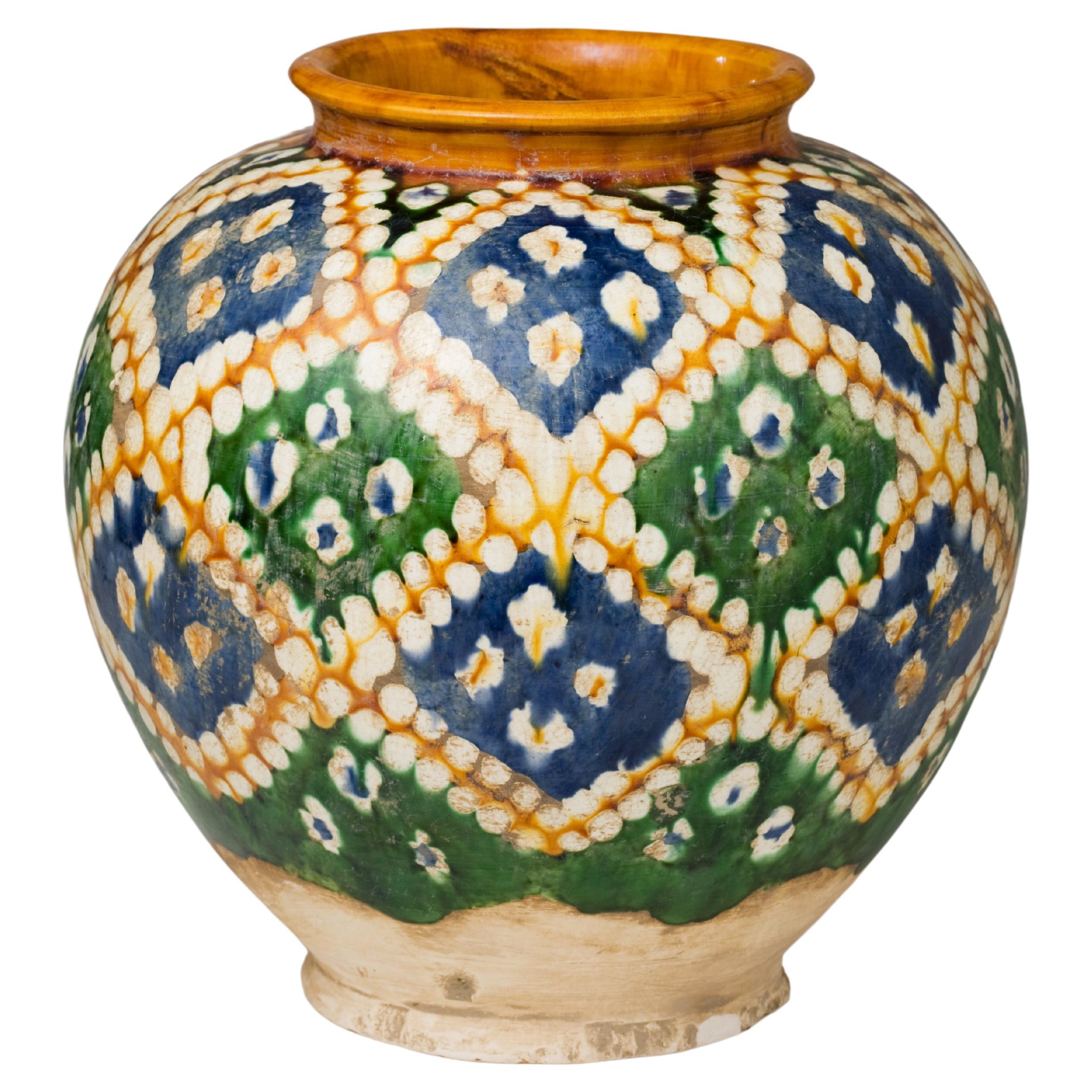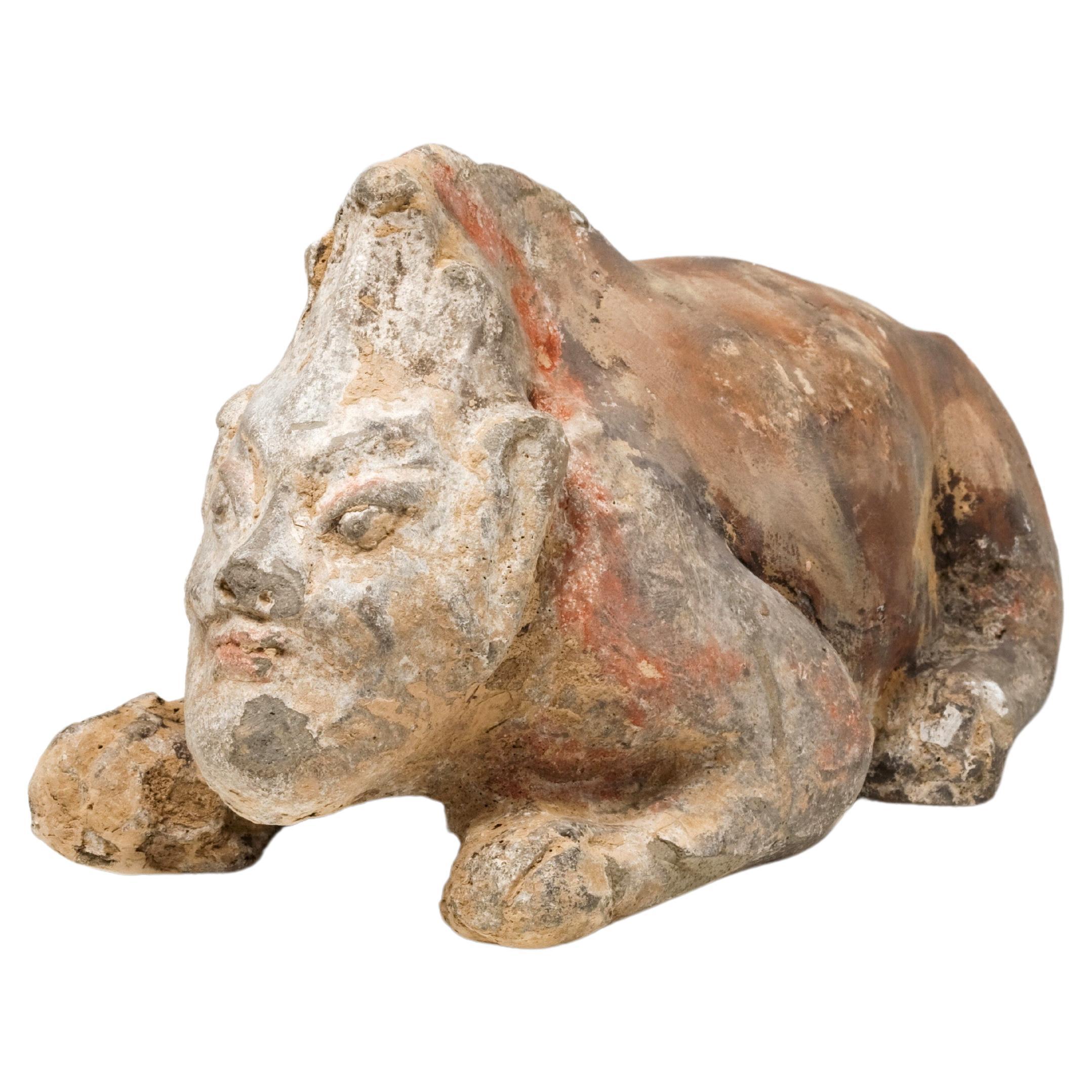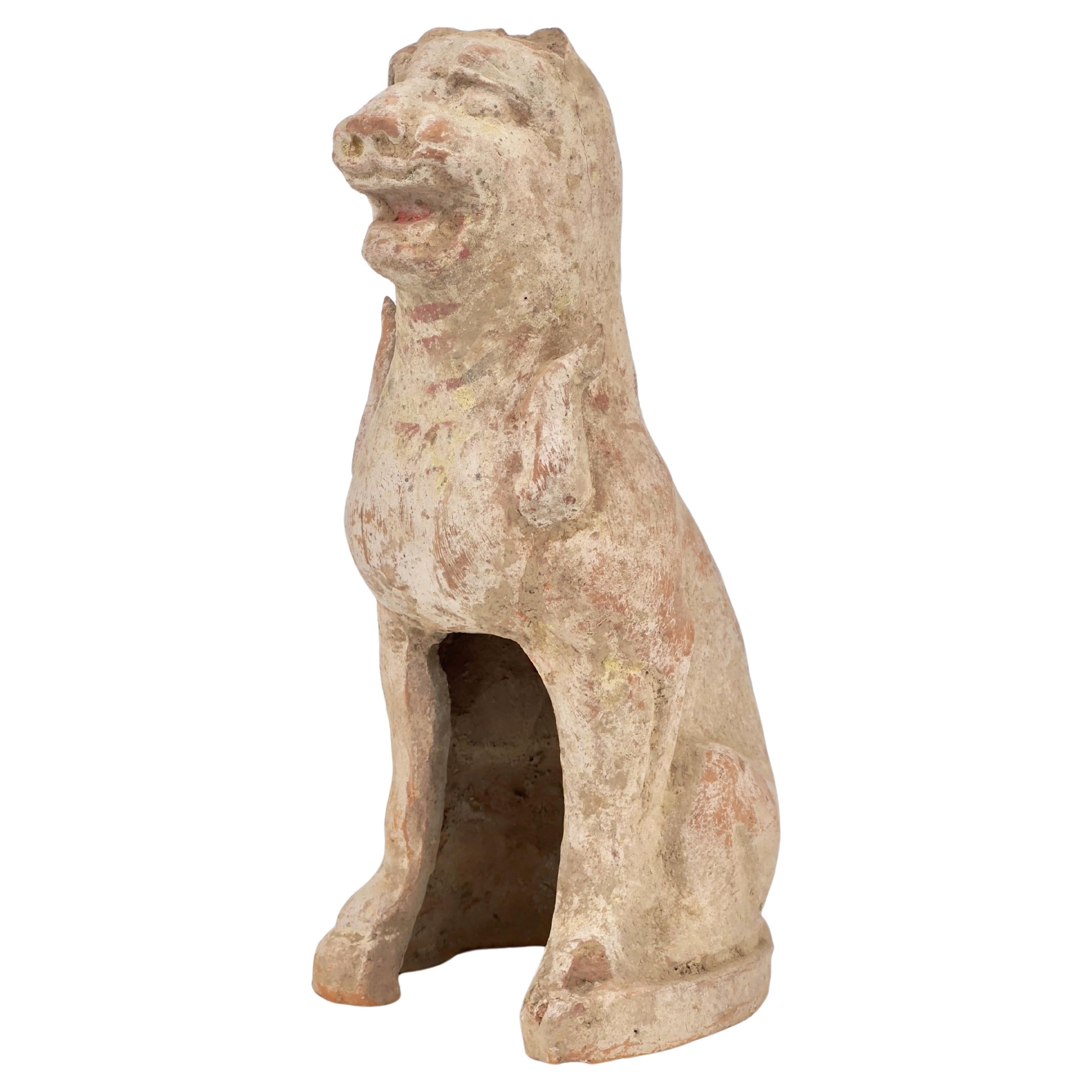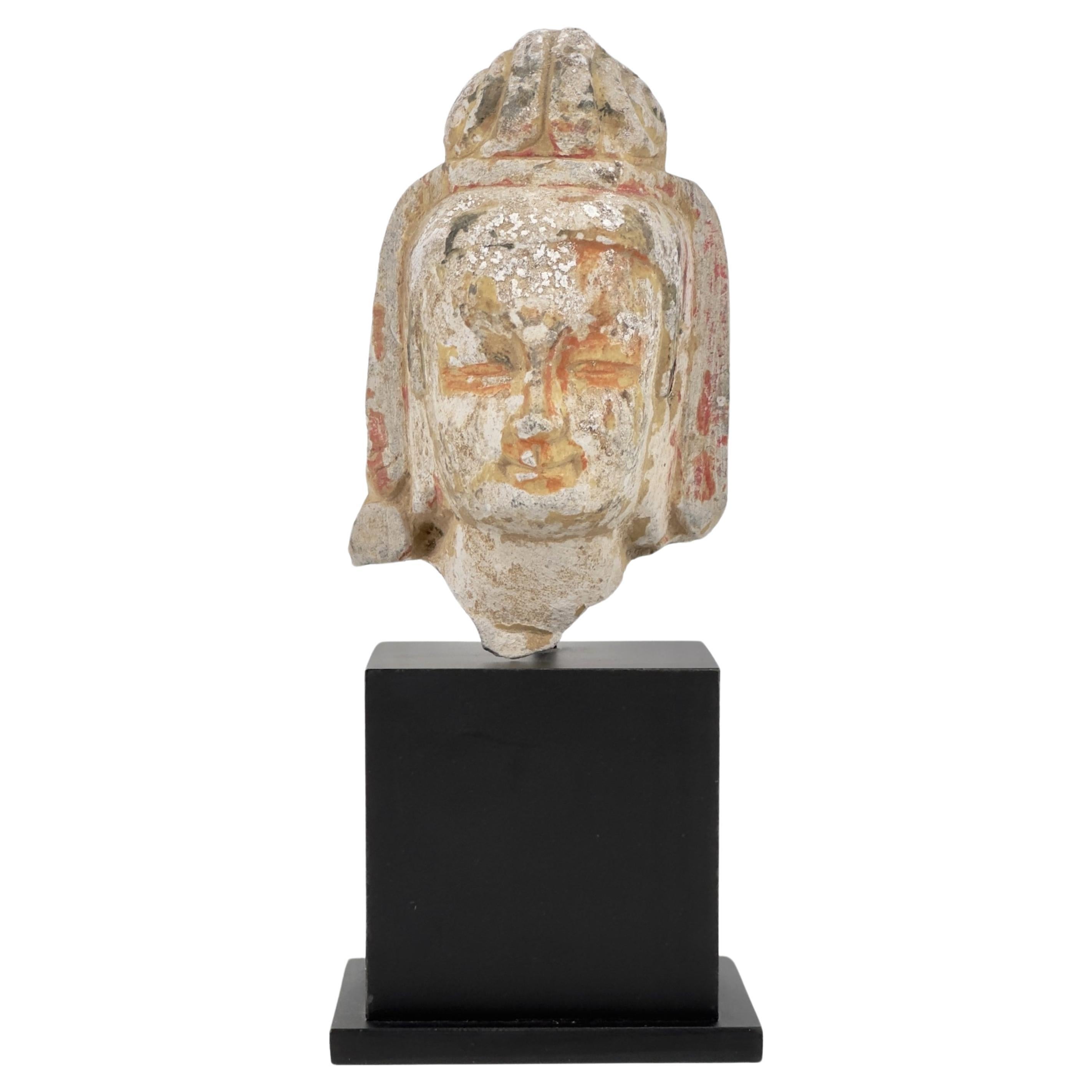Items Similar to Celestial being(Apsara) Stone Statue, Northern Wei-Tang Dynasty
Want more images or videos?
Request additional images or videos from the seller
1 of 14
Celestial being(Apsara) Stone Statue, Northern Wei-Tang Dynasty
About the Item
This statue appears to be a stone sculpture of an apsara, a celestial nymph from Buddhist and Hindu traditions. Despite its fragmentary state, the sculpture conveys grace and movement. The apsara is captured in a dynamic pose, perhaps once part of a larger tableau, playing a flute-like instrument. The facial features are serene yet expressive, with faint traces of pigmentation hinting at the sculpture's original polychromy. The black stand was made in Hong Kong at the time of the acquisition.
Date : Northern Wei-Tang Dynasty(5-8th century)
Dimension : 10.5cm (Height) x 8cm(Diameter)
Condition : Good
Provenance : Acquired in 1999, Hongkong
Reference : Bonhams London 11 Jun 2003 - Fine Asian Art - Lot 143
* Apsara
Apsaras, celestial beings gracing the skies of ancient lore, are often heralds of good fortune and the embodiment of positive energy. They float through the heavens with such grace and beauty that their presence is said to uplift the spirit and inspire joy in the hearts of those who witness them.
In many Asian cultures, Apsaras are regarded as benevolent spirits of water and clouds, thought to bring nourishing rains to sustain life and fertility to the earth. Their dances, celestial melodies, and elegant movements are believed to soothe the soul and bring harmony to the world.
Depicted with ethereal elegance, Apsaras are not merely dancers; they are muses of creativity and the arts. Artists, musicians, and poets seek inspiration from these divine figures, hoping to capture a fragment of their heavenly artistry.
In the presence of Apsaras, it's said that one's luck is sure to turn for the better, as they are symbols of good fortune. Their likeness adorns temples and palaces, not only as decoration but as a wish for prosperity, success, and the positive flow of energy.
Embracing the qualities of Apsaras in one's life can be seen as an aspiration to live in harmony with the beauty of nature, the arts, and the joyful melodies of existence. They remind us of the delight found in the natural world and encourage us to appreciate the everyday dance of life with a light heart and hopeful spirit.
- Dimensions:Height: 4.14 in (10.5 cm)Diameter: 3.15 in (8 cm)
- Style:Tang (Of the Period)
- Materials and Techniques:
- Place of Origin:
- Period:
- Date of Manufacture:5-8th century
- Condition:Minor losses. Minor fading.
- Seller Location:seoul, KR
- Reference Number:1stDibs: LU9577238987292
About the Seller
New to 1stDibs
Joined in the past six months.
4.5
Vetted Seller
These experienced sellers undergo a comprehensive evaluation by our team of in-house experts.
Established in 1999
1stDibs seller since 2023
Typical response time: <1 hour
- ShippingRetrieving quote...Ships From: seoul, Korea South
- Return PolicyA return for this item may be initiated within 10 days of delivery.
Auctions on 1stDibs
Our timed auctions are an opportunity to bid on extraordinary design. We do not charge a Buyer's Premium and shipping is facilitated by 1stDibs and/or the seller. Plus, all auction purchases are covered by our comprehensive Buyer Protection. Learn More
More From This SellerView All
- Stone Head of Bodhisattva, Northern Wei-Tang DynastiesLocated in seoul, KRThe face with downcast eyes and a smile, the hair swept up behind the pendulous ears into a high topknot. Faint traces of pigmentation hinting at the sculpture's original polychromy....Category
Antique 15th Century and Earlier Chinese Tang Antiquities
MaterialsLimestone
- Guardian Official Pottery Figure, Northern Wei-Tang DynastyLocated in seoul, KRThis figure appears to be a terracotta statuette, possibly representing a court official or a deity given the distinct headgear which could signify a rank or divine attribute. The st...Category
Antique 15th Century and Earlier Chinese Tang Antiquities
MaterialsEarthenware, Pottery
- Guardian Haitai Lion Pottery Figure, Northern Wei-Tang DynastiesLocated in seoul, KRThis figure represent a guardian haitai. The style of the figurine, with its facial features and remnants of paint, suggests it could be a part of funerary art, which was common in C...Category
Antique 15th Century and Earlier Chinese Tang Antiquities
MaterialsPottery, Stoneware
- Heavenly Beings Carved Limestone Stele Fragment, Northern/Eastern Wei DynastyLocated in seoul, KRFlying two heavenly beings depicted in the stone. They are celestial beings called an Apsara. While having the same fragment and shape, another work I uploaded exhibits small dots on...Category
Antique 15th Century and Earlier Chinese Han Antiquities
MaterialsLimestone
- Guardian(Half human half beast) Pottery Figure, Northern Wei-Tang DynastyLocated in seoul, KRThis guardian figure represents a fusion of human and beast, a common motif symbolizing protection in Chinese lore. Crafted from pottery, the figure is a testament to the era's sculp...Category
Antique 15th Century and Earlier Chinese Han Antiquities
MaterialsPottery
- Apsara Carved Limestone Stele with Extremely Rare 'Oolitic silica', Wei DynastyLocated in seoul, KRThe small dots apparent on the surface of this stone stele are indicative of an oolitic silica structure or oolites formed in what is known as "Oolitic chert." This formation occurs gradually over the course of thousands to several hundred thousand years within the soil or sea. Similar structures are commonly found in ancient fossils or arrowheads. Ancient peoples chose certain types of stones for tool-making, preferring materials that were easier to work with and could be sharpened effectively. This predilection is believed to be the reason why oolitic silica structures are frequently found in ancient arrowheads. The development of these oolitic silica structures is a very slow process involving the accumulation of siliceous layers around particulates. This phenomenon, where silica reacts with water to form layers around a nucleus, occurs under specific chemical and physical conditions. Typically, it takes thousands to hundreds of thousands of years for silica to gradually accumulate in layers through contact with moisture, a process that requires a precise harmony of many variables, including chemical conditions, temperature, pressure, pH, and biological activity. It is known that no other stele with such a silica structure has been identified to date, serving not only as evidence of its authenticity but also significantly enhancing the rarity of this piece. This stele appears to be a stone sculpture of an apsara, a celestial nymph from Buddhist and Hindu traditions. Despite its fragmentary state, the sculpture conveys grace and movement. The apsara is captured in a dynamic pose, perhaps once part of a larger tableau, playing a flute-like instrument. The black stand was made in Hong Kong at the time of the acquisition. Date : Northern Wei/Eastern Wei Dynasty(386~550) Size : 22cm (Height) x 16cm(diameter) Condition : Good (oolites dots on surface) Provenance : Acquired in late 1990s from Hongkong Reference : 1) Sotheby's New York 20 March 2018 - Jingyatang Treasures Of Chinese Buddhist...Category
Antique 15th Century and Earlier Chinese Han Antiquities
MaterialsStone, Limestone
You May Also Like
- Chimera (Pixiu) Terracotta Mythological Being - Tang Dynasty, China '618-907 AD'Located in San Pedro Garza Garcia, Nuevo LeonMagnificent Mythological Being "Chimera" with Human Face and Flaming Rays Halo. Orange Terracotta with Traces of Stucco and Painting. This creature is commonly known as Pixiu. Fierc...Category
Antique 15th Century and Earlier Chinese Tang Antiquities
MaterialsTerracotta
- Chinese Northern Wei Dynasty Terracotta Horse - TL TestedLocated in London, GBAn elegant hollow-moulded terracotta horse. This horse is modelled in a standing pose with its neck elegantly arched and its ears pricked forward attentively. The mane is indicated with the use of a scalloped red design with white dotted details. The head is well modelled with notched ears pricked on either side of a feather ornament, with a tasselled rope looped around the top of the neck and tufted ornaments on the chest collar, the back is covered with a long red cloth with white dotted detailing, gathered at the bottom atop the flaring mudguard. The rump is encircled by a series of intricate tassels, attached to a tufted back piece. This terracotta may represent a horse fitted for a parade. Horses were an important status symbol in ancient China. These animals were brought to China via the Silk Road and were considered luxury goods. As such horses were a sign of wealth among the elite, and there were strict laws which restricted the ownership of horses to people of elevated rank. In fact, soldiers serving in China’s military...Category
Antique 15th Century and Earlier Antiquities
MaterialsTerracotta
- Tang Dynasty Terracotta Pottery Statue of Civil Officer, Oxford TL TestedLocated in Greenwich, CTAn elegant and superbly sculpted pottery statue of standing civil official, Tang dynasty 618-907, come with oxford authentication TL test certificate. Oxford TL Test sample numbers: ...Category
Antique 15th Century and Earlier Chinese Tang Sculptures and Carvings
MaterialsTerracotta
- Pair of Very Refined Tang Dynasty Pottery Statue of Guardians, Oxford TL TestedLocated in Greenwich, CTA pair of very refined standing pottery statue of guardians, dramatic facial expression, beautiful detail, early Tang dynasty 618-907, come with one Oxford authentication TL test cer...Category
Antique 15th Century and Earlier Chinese Tang Antiquities
MaterialsTerracotta
- Chinese Tang Dynasty Pottery Court LadyLocated in Austin, TXPainted pottery figure of an opulent Chinese court woman with up-swept hair and standing in a simply draped robe from the Tang Dynasty (618-907 AD). Her beauty is illuminated by the ...Category
Antique 15th Century and Earlier Chinese Tang Antiquities
MaterialsPottery
- Pair of Tang Dynasty Painted Pottery SoldiersLocated in Austin, TXA well modelled pair of Tang dynasty painted pottery soldiers. The warriors portrayed standing, dressed in form fitting, elaborate layered Armor with fitted helmets. The breastplate...Category
Antique 15th Century and Earlier Chinese Tang Figurative Sculptures
MaterialsPottery





